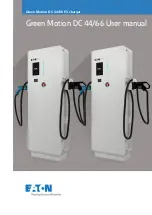3.0
LM3647 REFERENCE DESIGN DEMO-BOARD
The demo-board provides a combined multi-chemistry
solution with hardware for both external constant current
source and LM3647 controlled charge current. Located near
the top-left corner of the board is the power supply connector
(next to the heatsink). When using the external constant
current source, a power resistor needs to be connected at
the connector marked 317-resistor. The values of the resistor
can be calculated using the equation 4 mentioned earlier.
At the bottom-right corner of the board are two connectors
that lead to the battery and discharge resistor. The value of
the discharge resistor depends on the battery pack voltage
and the maximum discharge rate. The demo-board has
different jumpers that are assigned to different setups. Some
of the components are not populated, providing support for
user-specific values.
The timeout jumper J18 is used to select different timeouts
from 2.4C to 0.4C. The values mounted on the demo-board
result in timeouts corresponding to the charge-rates shown
below:
The PWM jumper J7 is used to connect the PWM-signal to
either the external constant current source (marked slow) or
the RC-filter that is connected to the operational amplifier
(marked fast).
The PWM-FB jumper J14 is used to select different
amplification levels of the PWM signal. The jumper with the
battery voltage ranges are shown below:
The I jumper J10 is used to select between different current
sense resistors. The values mounted are 0.047
Ω
and
0.100
Ω
.
The different current sense voltage amplification level is
selected via CURRENT jumpers J9 and J13 (both jumpers
must be changed in pairs, see figure below).
The upper values correspond to a current sense resistor of
0.047
Ω
while the lower correspond to 0.100
Ω
(see previous
figure).
The battery voltage is selected with the Voltage jumpers J11
and J12 (see below for settings).
The jumper J3 is used to connect to an optional
NTC-resistor. If no temperature sensor is used, the jumper
J8 must be shorted. The Demo-board was designed for an
NTC thermistor from Siemens (B57861S302F40) with the
following specifications: 3k
Ω
@
25˚C,
β
= 3988. If an NTC
with different characteristics is used, then the resistor R28
may need to be changed. The charger uses voltage levels to
trigger under/over temperature conditions. The voltage at the
temperature-input must be between 2.2V or 0.5V for the
charger to start. During charging the voltage must stay
between 3.0V for Li-Ion, or 3.15V for Ni-Cd/Ni-MH, and 0.5V
or the charger will register a temperature fault and abort the
charge.
The three jumpers J2, J5 and J6 are connected to the three
selection-pins SEL1, SEL2 and SEL3. These jumpers are
used to select how the charger should behave (see Charger
Modes table).
AN101315-10
AN101315-11
AN101315-12
AN101315-13
AN101315-14
AN101315-15
AN101315-16
AN-1
164
www.national.com
8


















